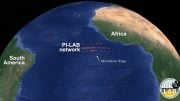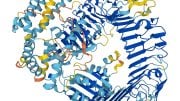
Researchers from the Ningbo Institute achieved a breakthrough with the first flexible perovskite/silicon tandem solar cell, reaching 22.8% efficiency and high durability, paving the way for lightweight, high-performance solar cells. (Artist’s concept.) Credit: SciTechDaily.com
A new study highlights the successful development of the first flexible perovskite/silicon tandem solar cell with a record efficiency of 22.8%, representing a major advance in flexible solar cell technology.
Although rigid perovskite/silicon tandem solar cells have seen impressive advancements, achieving efficiencies as high as 33.9%, the development of flexible versions of these cells has been limited. The main hurdle is improving light absorption in the ultrathin silicon bottom cells without compromising their mechanical flexibility.
In their pioneering study, a research team led by Dr. Xinlong Wang, Dr. Jingming Zheng, Dr. Zhiqin Ying, Prof. Xi Yang, and Prof. Jichun Ye from the Ningbo Institute of Materials Technology and Engineering, Chinese Academy of Sciences, has successfully demonstrated the first flexible perovskite/silicon tandem solar cell based on ultrathin silicon, with a thickness of approximately 30 µm. By reducing wafer thicknesses and adjusting the feature sizes of light-trapping textures, they significantly improved the flexibility of the silicon substrate without compromising light utilization. Additionally, by capping the perovskite top cells, they enhanced the mechanical durability of the device, thus addressing concerns related to fractures in the silicon surface.
Performance and Durability
The resulting flexible perovskite/silicon tandem solar cell achieved a certified stabilized efficiency of 22.8%, setting a record efficiency for flexible solar cells. Furthermore, with an exceptional power-to-weight ratio of 3.12 W g−1, the device promises high performance in a lightweight package. Remarkably, the flexible tandems exhibited outstanding bending durability, maintaining 98.2% of their initial performance even after undergoing 3,000 bending cycles at a radius of only 1 cm.
In conclusion, the breakthrough achieved by Professor Jichun Ye and his team represents a significant advancement in the development of flexible photovoltaic technology. Their research not only demonstrates the feasibility of flexible perovskite/silicon tandem solar cells but also opens up new avenues for the practical application of high-efficiency, lightweight solar cells in various fields.
Reference: “Ultrathin (∼30 µm) flexible monolithic perovskite/silicon tandem solar cell” by Xinlong Wang, Jingming Zheng, Zhiqin Ying, Xin Li, Meili Zhang, Xuchao Guo, Shiqian Su, Jingsong Sun, Xi Yang and Jichun Ye, 13 April 2024, Science Bulletin.
DOI: 10.1016/j.scib.2024.04.022
The study was funded by the National Natural Science Foundation of China, the National Key Research and Development of China, and The Key Research and Development Program of Ningbo.









Great! Now, how many years before it hits the market and how many decades before they figure out how to recycle the damn thing?
@ Mr Fett, your comment was a buzzkill. China is wise to do this state-funded R&D just as we are with our DOE and Darpa stuff. Here, however, we kinda use kid gloves about stepping on the pscho-billie’s toes because it may cause a food fight over IP money.